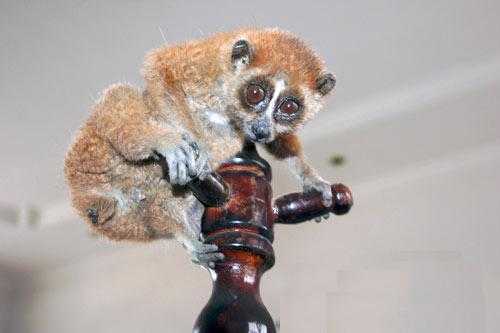Nycticebus pygmaeus
IUCN
LCBasic Information
Scientific classification
- name:Nycticebus pygmaeus
- Scientific Name:pygmy loris,Xanthonycticebus pygmaeus,Little slow loris,wind monkey, little wind monkey
- Outline:Primates
- Family:Primates Lorisidae Nycticebus
Vital signs
- length:19-23cm
- Weight:222~750g
- lifetime:10year
Feature
Similar to the slow loris, but smaller
Distribution and Habitat
Mainly distributed in China, Vietnam, Laos, Cambodia and other countries.
In China, it is only distributed in Hekou, Jinping, Luchun, Malipo, Maguan, Mengzi, Pingbian, Wenshan and other areas in Yunnan.
The pygmy slow loris generally chooses tropical and subtropical rainforests, evergreen broad-leaved forests, bamboo forests, etc. as living environments, and chooses the branches of tall trees with vines, dense shrubs or the top of bamboo branches in bamboo forests as habitats. The habitats are usually more than 8m above the ground. They mostly live in virgin forests below 500m above sea level.
Appearance
The body is cylindrical, with fine velvety hair, mainly brown-orange or brown-yellow, and there is often a brown-brown stripe in the middle of the back. The tail is very short and usually hidden in the hair. The snout is short, the face is round, and the head is round. The eyes are large and round, and the eye circles and surrounding hair form a brown ring. The skin of the nose, auricle, hands and feet is black, and the belly hair is grayish white. The limbs are short and thick, the hind limbs are slightly longer than the forelimbs, the inner side of the upper arm of the forelimbs has a poison gland, the second toe of the hind foot has a hooked claw, and the other fingers (toes) have flat nails.
The pygmy slow loris is an omnivorous animal that tends to be insectivorous and has specialized feeding behaviors such as peeling bark and eating gum. Under artificial breeding conditions, the pygmy slow loris likes to eat insects such as locusts and cockroaches and live animals such as quai
Details
The pygmy slow loris is the smallest prosimian species in China. It is very similar to the slow loris but smaller in size, only half the size of the slow loris.

The habitat and living habits of the pygmy slow loris are similar to those of the slow loris. It is mild-tempered, nocturnal, arboreal, and rarely goes to the ground. It spends its activities, foraging, mating, reproduction, and sleep in trees. During the day, it curls up in a ball and hides in the tree holes of tall trees, near the lush canopy of branches and leaves, or on the forks of dense branches to rest. It starts to move around and forage after dusk. They like to move alone and move very slowly, mostly climbing, without jumping, and only speed up when attacked.
When the pygmy slow loris is attacked, the glands on the inside of its elbow can produce toxins. When combing its hair, the toxins will spread throughout its fur, and they will roll into a ball, leaving only the poisonous fur outside. When the predator is in the tree, they will also roll into a ball and fall from the tree to escape danger. Sometimes they will take the passive defense method of biting with teeth to escape from the enemy.
In 1988, China estimated that its number was 300~500, and the 2009 State Forestry Administration's survey of China's key terrestrial wild animal resources found that there were 90. If protection efforts are not increased, there is a risk of extinction. In 2012, there were about 72,000 wild slow lorises in the world and about 183 in captivity. Only a small number were found in the Vietnamese market. They are also common in the forests of Laos, but less than in Vietnam. The global population is declining.
Main causes of endangerment: habitat destruction, deforestation and destruction of tropical rainforests and monsoon forests in Indochina, resulting in the shrinkage and deterioration of the habitat; illegal hunting for pets, low population growth rate and illegal pet breeding among the people.
The nature reserves in China where slow lorises are distributed include Maguan Laojunshan Nature Reserve, Pingbian Daweishan Nature Reserve and Jinping Watershed Nature Reserve.
Listed in the first level of the "List of National Key Protected Wildlife in China".
Listed in the World Conservation Union (IUCN): Vulnerable.
Listed in the Convention on International Trade in Endangered Species of Fauna and Flora (CITES): Appendix I.
Protect wildlife and eliminate game.
Maintaining ecological balance is everyone's responsibility!








